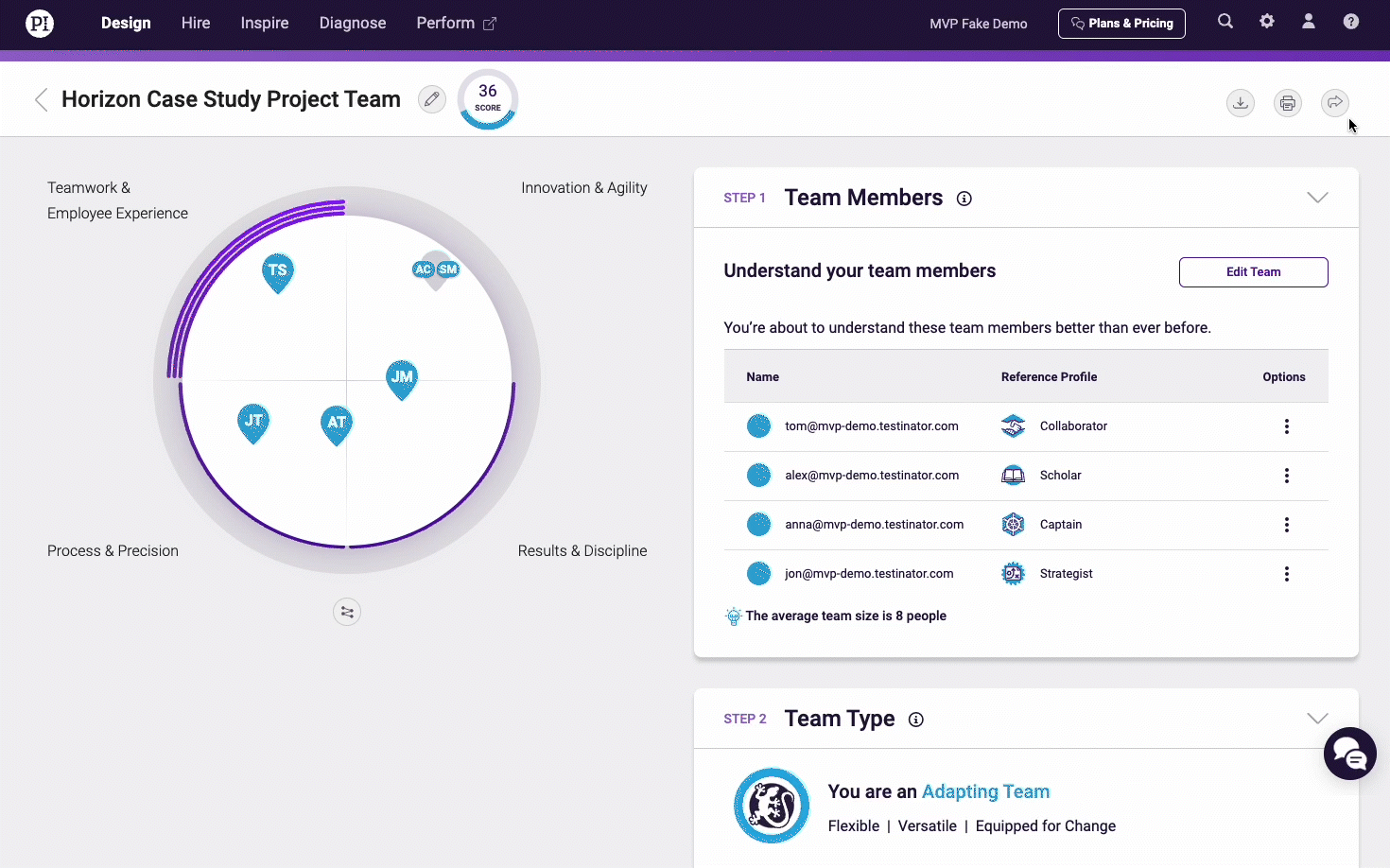There are lots of situations you can predict and prepare for. You could put together a plan for when sales are down, or for when an executive or manager unexpectedly leaves. You could even create contingency plans for unlikely situations, such as a sudden market crash or bankruptcy.
But even if you have a folder full of plans for every conceivable situation, you’ll never be truly prepared unless you know how to respond to change itself. This is the secret of today’s most agile organizations. Instead of spending time preparing for what they think might happen, they put their energy toward managing change of any kind, whether that means implementing new processes, overcoming obstacles, or evolving the entire business.
A personalized leadership approach for each team member.
PI’s behavioral insights help leaders inspire and coach each employee in a way they truly connect with.
Let’s explore what makes organizational change management so essential these days, as well as how you can effectively deploy it.
What is organizational change management?
Organizational change management is a systemic set of tools, resources, and processes for preparing, responding, and adapting to change. It involves creating an overarching methodology that can be used to successfully guide the organization as it navigates a challenge, introduces new initiatives, and/or adjusts to evolving circumstances, while also minimizing negative outcomes.
Change management can affect many aspects of the organization. Although it often involves project management tasks, it can also be used to alter the roles and responsibilities of leadership, affect the functions of HR, improve communications, and even transform the culture of the organization itself.
Importance & relevance in today’s business world
Change is unavoidable for the modern organization. In fact, the rate of change may only be increasing. According to Gartner, a typical organization now undergoes as many as five major changes in as little as three years. What’s more, three out of four organizations expect this number to keep on growing. This makes knowing how to effectively respond and adapt to change vital to an organization’s success.
But change management is not only important for helping shepherd businesses through periods of change – it can also encourage employees to recognize and accept the need for change in the first place. After all, change can be difficult, which often means the first impulse for many people is to resist it.
Organizational change management initiatives counteract this by offering employees a systemic framework they can follow. This may include a road map, a detailed communications plan, integrated training programs, and more. As a result, employees will feel more capable of successfully managing change. In turn, this will help reduce costs, improve morale, and increase organizational effectiveness.
Types of organizational change
There are many different ways change can affect an organization. It may happen quickly and all at once. Or it may be smaller and more incremental. Alternatively, it may affect only a single aspect of the business, or touch nearly every part of it. For this reason, organizational change management initiatives can be organized into a number of different types:
- Incremental: This is when change is introduced through a series of small adjustments. Because they often take place over a long period of time, these tweaks can result in improvements gradual enough to prevent any major disruptions.
- Transformative: The opposite of incremental change, this type of initiative is large and dramatic. Nearly every aspect of the organization gets restructured, from its mission and goals to its day-to-day operations.
- Corrective: This type of change initiative is put in place in response to some kind of threat or misstep. Like a disaster response kit, a corrective change management strategy may be implemented after an important client leaves or a product fails unexpectedly.
- Technological: This category refers to when an organization adopts a new software system or replaces some other type of technology they were previously dependent on. The success of this type of change is often contingent on proper training and support.
- Cultural: In this type, an organization introduces changes to its shared values, attitudes, behaviors, and any other aspects that make up its culture. This may happen either in response to an event, such as an increase in resignations, or in anticipation of what employees want.
- Structural: This refers to any shift in how the organization functions. It may involve a change in leadership, a restructuring of teams or business units, or some combination. Keeping open lines of communication throughout is key to this type of change initiative’s success.

Organizational change preparation
Addressing change may be necessary, but it can still feel daunting. Even when you have a plan in place, steering an organization, as well as its people, out of its old habits is rarely a simple task. That’s why it’s important to get started on the right foot. Here are some steps you should take to prepare for organizational change.
- Define and understand the need for change. Before anything is done, you should be able to clearly articulate both the problem that requires change and the type of change needed. Put into writing how the organization has been affected by this problem, as well as any possible consequences of not taking action. Then propose your solution, detailing how this change will address the challenges you’ve already described.
- Gather up support from your colleagues. The earlier you can convince others of the need for change, the more successful your change initiative is likely to be. Hopefully, you’ll have sketched out the challenge and your proposed solution so well that this step will be easy. If not, take the time to sit down and talk with any holdouts. Listen to their concerns, then try to address them one by one. This effort will be worth it in the long run.
- Create a roadmap for success. Once enough people are on board, start working with them to create a roadmap for change that lays out the details of how you will achieve your goals. This should include information about how this change will affect everyone (teams, individual employees, and customers alike), important milestones to meet for success, and any details on the roles and responsibilities for carrying out your plan.
- Ensure your process plan aligns with larger business goals. While writing out your roadmap, it’s also important to draw a clear connection between the change management plan and your organization’s overall business goals. How does your plan further the mission or vision of the organization as a whole? Or, if it takes a more transformational approach, how are you justifying changing this mission? Be sure to explain the sustainability of your plan to convince stakeholders of its viability.
The role of leadership during organizational change
In order for a change management plan to be successful, everyone has an important role to play. But it’s the responsibility of leadership to ensure everyone is aware of this – and never forgets it.
To accomplish this, leaders have to be able to both keep the larger picture in mind and continuously articulate it to their employees. Why is this change necessary? What are the benefits of going through this process and why are they worth it? This will require exceptional communication skills, as well as an ability to motivate and inspire employees when they begin to get discouraged.
Successfully leading an organization through change also requires a good amount of courage. That’s because even the best laid plans involve risk. Leaders need to be willing to embrace uncertainty as they push for change throughout the organization. But they shouldn’t be reckless. Instead, they should pair this courage with strong organizational skills, attention to detail, and a talent for decision-making. They should know how to delegate tasks and select others to lead different aspects of implementation. This way, they can ensure everyone has a stake in the plan’s success.

Addressing opposition to change
Resistance is all but inevitable while implementing a change in an organization. Employees may feel anxious about what they don’t know, or they may be afraid they will lose a certain amount of control over their job or situation. They may have even had a negative experience with organizational change in the past.
Regardless of the reason, it’s important to both acknowledge these fears and address them. Here are some strategies for doing just that.
- Transparent communication: You might have an airtight plan for implementing change, but if you don’t effectively communicate it to your team, they likely won’t get on board. Instead, you should aim to keep your employees as informed as possible. Start out by justifying the reasons for change, then make sure they understand the individual steps and milestones. If necessary, call an all hands meeting to thoroughly explain what is happening, then offer to answer questions. Do whatever it takes until everyone is comfortable.
- Inclusive decision-making: If you can make your employees feel like they’re in control of their situation, they’ll be much less likely to resist. A great way to do this is by actively involving them in the change process. You can do this by working closely alongside them as you come up with your strategy. Solicit their opinions and check back in with them frequently – daily even – in order to keep them involved and up to date. This will give them a stake in the change management plan they might not otherwise have.
- Empathy and support: Although transparent communication and inclusive decision-making can help, anxiety over change can still linger for many reasons, such as a fear of adopting new technology or apprehension about taking on new responsibilities. This makes it important to show empathy and offer support. An effective way to do this by simply taking the time to listen to employee concerns. Do what you can to assuage their fears, but also ask them how you can help them out. You could even create a dedicated group that can offer workers extra resources through the change period.
- Training and education: A big reason why employees may be resisting change is that they don’t feel prepared for it. But by offering to help them address any of their shortcomings, you can help ease this fear and prepare them to take on change. A good way to do this is by taking an incremental approach that gradually introduces change alongside relevant training opportunities. It can also be smart to empower managers to help educate their own teams and address any skills gaps their individual members may have.
Evaluating change effectiveness
Organizational change management doesn’t stop at implementation. In fact, once you’ve put change into motion, it’s equally as important to continuously check in and monitor its effectiveness. After all, successful change initiatives are rarely short-term projects. More often, they will involve a series of smaller and more incremental changes, accompanied by ongoing adjustments to ensure milestones are being met and goals achieved.
But what’s the best way to evaluate the performance of your change management approach? While this will depend on the its specifics, the following three methods can give you a general framework to follow:
- Program performance: This approach evaluates the overall execution of your change management program. In other words, it looks at whether the specified change was completed, how well this change was executed, and how effective the change management program was.
- Individual performance: This is a measurement of how much the implemented change impacted the individuals involved. It should look at the rate of adoption, how quickly the adoption occurred, and how proficient these individuals are with the new change.
- Organizational performance: This considers the effectiveness of the change against the larger needs or goals of the organization. Did the change management program deliver the desired outcome? The sustainability of any accrued benefits should also be considered in order to determine the long-term success of the project.








